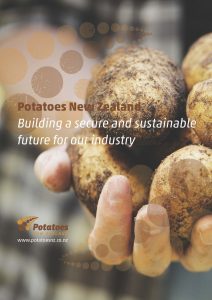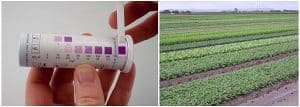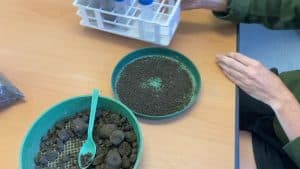
Potatoes NZ is building a sustainable future for our growers.
NZ Potato Industry Strategic Targets 2022
1. Double the value of fresh & processed exports by 2025.
2. Zero net nutrient and GHG emissions by 2035.
Meet our top 3 Sustainability Champions: Oakleys, Bhana Family and Wilcox Goodness.
Potatoes New Zealand is currently leading a collaborative, 6 year project called Sustainable Vegetable Systems (SVS) which aims to provide the best tools for growers to maintain both regulatory and social license to grow.
We encourage the use of the Quick N test to understand and manage your soil and crop’s optimum nutrient application.
To develop your nutrient budget, estimates are required for the crop’s demand for nitrogen and how much of this will be supplied by the soil.
There are two tests used to quantify soil nitrogen supply.
- The mineral N test (Quick N test), which provides a measure of how much nitrogen is immediately available for plant uptake.
- The anaerobically mineralisable N (AMN) test. This is an estimate of the N supply from the mineralisation of organic N.
For an effective nitrogen mass balance, both sources of nitrogen need to be measured. An AMN test can be done annually but the amount of mineral N in the soil can change quickly over a short period of time, especially as crops take up nitrogen. Quick N tests strips can be used at any point in the rotation to give a real-time snapshot of the mineral N levels in your soil
- Measure the soil nitrogen supply with nitrate quick test strips.
- Use the test-strip result to make an informed fertiliser decision for the crop.

Download the Quick N test guide here
You can purchase Quick N tests from this supplier https://www.labsupply.co.nz/
Watch our short video on how to do the testing https://youtu.be/ruVLdjyd2mk

Government Activities & Policy’s on Environment which will affect our industry
CLIMATE CHANGE
GREENHOUSE EMISSIONS
The Ministry for Environment’s Primary Sector Partnership He Waka Eke Noa (HWEN) aims to collaborate on a framework and deliverables like GHG farm planning guidance. HWEN partners and industry bodies (Horticulture NZ), are identifying how to wrap the information into existing farm plans, to make things as integrated as possible for our busy farmers. See files below for HWEN flyer.
HWEN goals
- 25% of farms knowing their emissions by the end of this 2021
- 100% of farms knowing their emissions by the end of 2022
- 25% of farms having GHG in their farm plans by 2022
- 100% of farms having GHG in their farm plans by 2025.
MfE changes to managing nitrates and phosphorus can be read about in the folder of files at the bottom of this page.
FRESHWATER
The Ministry for Environment Freshwater changes can be read about here and why Freshwater matters here.
MfE Policy Statement on Freshwater is here. A National Policy Statement sets out objectives and policies that apply nationally.
MfE Environment Standards for Freshwater here. A National Environmental Standard is a set of ‘rules’ which apply nationally – they are like rules in a plan, and are implemented/enforced by Councils. A summary of what the NES for Freshwater means for growers can be read from the file below.
What is Te Mana o te Wai? The wholistic concept for our water. You can read about it here or see the folder of files at the bottom of this page.
Mfe has some great short videos explaining TMOTW as well.
Te Mana o Te Wai videos:
- Te Mana o te Wai introduction and overview
- Te Mana o te Wai – engaging with iwi and hapū
- Te Mana o te Wai – mahinga kai
- Te Mana o te Wai – an update for council planners
- Te Mana o te Wai – councils giving effect to the policy
WHO IMPLEMENTS THE CHANGES?
GREENHOUSE EMISSIONS
The recently passed Resource Management Amendment Act 2020 made changes to the ability to consider climate change as part of Resource Management. This aligns with the evolution of broader climate change policy, including the policy goal to transition to net zero carbon emissions by the second half of the 21st Century.
This means that from 31 December 2021:
- the sections of the Resource Management Act which prevented Councils from being able to consider the effects of discharges of greenhouses gases on climate change will be removed and
- councils must have regard to emissions reduction plans and national adaptation plans (prepared under the Climate Change Response Act) when making or amending their regional or district plans.
FRESHWATER
Regional (and unitary) councils have functions under the Resource Management Act of managing freshwater in the following ways:
- the control of the use of land for the maintenance and enhancement of water quality and ecosystems in waterbodies.
- the control of the taking, use, damming, and diversion of water, and the control of the quantity, level, and flow of water in any water body.
Councils are required to, through their regional plans, give effect to National Policy Statements. The freshwater provisions (objectives, policies and rules) in regional plans are the vehicle for giving effect to the NPSFM.
Councils must give effect to the NPSFM ‘as soon as reasonably practicable’ and notify a plan or plan change by December 2024. See our Plan Changes page for PNZ advocacy for growers on Plan Changes.
Useful Resources on Climate Change & Environment from a NZ & global perspective.
| Name | Downloads |
|---|---|
| Name | Downloads |
| 573 downloads | |
| 496 downloads | |
| 1223 downloads | |
| 503 downloads | |
| 514 downloads | |
| 638 downloads | |
| 538 downloads | |
| 501 downloads | |
| 613 downloads | |
| 512 downloads | |
| 636 downloads | |
| 1027 downloads | |


